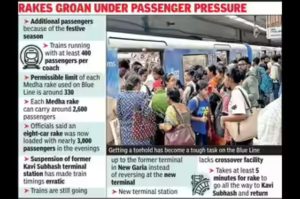Kolkata Metro Blue Line: Kolkata Metro’s Blue Line (North–South corridor), the city’s oldest and busiest route, is struggling under an unprecedented load of passengers. Despite introducing 284 daily services (22 more than earlier), the trains continue to run beyond safe capacity. During peak hours, compartments resemble overstuffed boxes, with commuters squeezed shoulder-to-shoulder and station platforms turning into pressure points of chaos.
The problem has intensified with the festive season approaching. As Durga Puja shopping picks up, thousands of additional passengers are flooding stations like Esplanade, Kalighat, Sovabazar, Dum Dum, and Garia, worsening an already strained system.

Kolkata Metro Blue Line: Festivity Meets Frustration
While festivals are Kolkata’s pride, they often put unimaginable pressure on the city’s infrastructure. This year, the timing has been particularly challenging:
- Kavi Subhash Terminal Remains Shut: Since July 28, the terminal has been closed due to cracks, forcing trains to reverse at Shahid Khudiram. Each reversal adds five extra minutes, slowing down schedules across the line.
- New Connections Redirect More Commuters: With the expansion of the Green Line (East–West) and the opening of the Yellow Line, more passengers are now using the Blue Line as a feeder route, increasing traffic at interchange hubs.
- Festive Shoppers Swell the Numbers: Commuters heading to malls, markets, and Puja pandals are joining office-goers, leading to crush-load conditions throughout the day.
An office commuter who shared her ordeal on social media summed it up: “People like us can’t even reach office properly. Waiting 20 minutes for a train and then pushing through suffocating crowds—this is not the metro we knew.”
Ridership Explosion Across the Network
While the Blue Line is choking, other corridors are registering record numbers too. The Green Line (East–West Metro) has recently crossed 1.9 lakh passengers in a single day, even touching 2.3 lakh on certain occasions. Stations such as Howrah Maidan, Sealdah, Central Park, and Salt Lake Sector V have seen sharp spikes in ticket sales, reflecting a growing dependency on the metro.
This surge is a positive sign of urban mobility, but without proportionate upgrades, the very success of metro expansion is turning into a commuter nightmare.
Attempts at Relief: Small Steps, Big Gaps
Metro authorities have been attempting to manage the crisis:
- Additional Services: Daily Blue Line trips increased from 262 to 284.
- Reduced Headway: Peak-hour intervals shortened from six to five minutes.
- On-ground Personnel: Railway Protection Force (RPF) and metro staff are manually regulating passenger flow and even shutting train doors at crowded stations.
Despite these measures, bottlenecks remain. Just this week, a train at Esplanade was delayed due to door malfunctioning, leading to a dangerous build-up of passengers on the platform. With a 30-minute gap before the next service, commuters were stranded, sparking heated protests and further chaos.
Why the Crisis Persists
Several structural and operational reasons explain why overcrowding refuses to ease:
- Limited Infrastructure: Blue Line trains are already running at maximum frequency. Any further reduction in intervals risks system instability.
- Terminal Constraints: The closure of Kavi Subhash terminal has disrupted scheduling, cutting efficiency at the southern end.
- Dwell Time Delays: Crowding increases the time trains must halt at each station, triggering ripple-effect delays across the network.
- Interchange Overload: Esplanade, Sealdah, and Dum Dum have become choke points as passengers pour in from other lines.
Experts in transport engineering note that unless inflow is regulated during peak times, trains will continue to “chase congestion,” with each delay compounding the next.
Commuters Voice Anger
The crisis has reached a point where commuters are openly comparing the Blue Line experience to local trains, traditionally known for their overcrowding. Social media platforms are filled with videos of packed coaches and long queues.
One frustrated passenger posted: “The metro used to be our pride. Now it feels like a punishment every day.”
The Way Forward: Possible Solutions
Kolkata Metro authorities and urban planners have outlined a few possible strategies to address the crisis:
- Faster Completion of Shahid Khudiram Terminal Work: Once functional, train turnaround time will improve, restoring smoother schedules.
- Staggered Work and Shopping Hours: Coordination with offices and shopping districts could help spread rush-hour loads.
- Feeder Bus and Auto Services: Linking buses and autos directly to metro stations could divert short-distance passengers away from train congestion.
- Platform Management Systems: Modern crowd-control measures, including entry restrictions and flow channels, can minimize stampede risks.
- Upgraded Rolling Stock: Adding longer trains with more coaches may eventually become inevitable.
The Larger Picture: Success Turning Into Strain
The irony of Kolkata Metro’s present situation is stark: the very expansion and popularity that symbolized progress are now exposing weaknesses in capacity and planning. With new lines operational, people are shifting to metro travel en masse, abandoning other modes like buses and taxis. While this represents a welcome transformation in sustainable urban transport, the system must scale up to absorb this growth.
For now, the Blue Line stands as a warning: without timely infrastructural upgrades, Kolkata risks turning its most celebrated public transport success into a daily struggle for its people.
External References for Context
Also read: Home | Channel 6 Network – Latest News, Breaking Updates: Politics, Business, Tech & More

